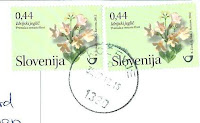This is a card from a new Unesco sites. Idrija, together with Almadén in Spain, were added to the World Heritage List this year, under the name Heritage of Mercury - Almadén and Idrija. I've got this card thanks to Vesna.
Idrija is a small town and municipality in the Goriška region of Slovenia. It is known for its mercury mine.
Mercury was discovered there in 1497. Idrija is one of the few places in the world where mercury occurs in both its elemental liquid state and as cinnabar (mercury sulfide) ore. The subterranean shaft mine entrance known as Anthony's Shaft (Antonijev rov) is used today for tours of the upper levels, complete with life-sized vignettes of workers over the ages. The lower levels, which reach to almost 400 meters below the surface and are no longer being actively mined, are currently being remediated. - in: wikipedia
Mercury was discovered there in 1497. Idrija is one of the few places in the world where mercury occurs in both its elemental liquid state and as cinnabar (mercury sulfide) ore. The subterranean shaft mine entrance known as Anthony's Shaft (Antonijev rov) is used today for tours of the upper levels, complete with life-sized vignettes of workers over the ages. The lower levels, which reach to almost 400 meters below the surface and are no longer being actively mined, are currently being remediated. - in: wikipedia
Photo by Dusan Jez
Castle Gewerkenegg dominates the old core of Idrija. It was erected at the beginning of the 16th century to serve as the administrative headquarters and warehouse of the Idrija mine, then the second largest mercury mine in the world.
The now beautifully restored Renaissance complex experienced a Baroque renovation in the middle of the 18th century when the inner arcaded courtyard was created and painted with attractive decorative frescoes. The castle now houses the Idrija Museum, whose central exhibit-Five Centuries of Mercury Mining and the Town of Idrija-offers a survey of the half-millennium history of the oldest mining town in Slovenia. It also offers an exhibit of Idrija lace, a replica of a room in an Idrija miner's home, peasant frescoes, memorial rooms of the writer France Bevk and the politician Aleš Bebler, and a collection of paintings donated by the gallery owner Valentina Orsini Mazza.
The castle also provides rooms and a concert hall for the Idrija Music School.
The only castle in Slovenia built not for feudal lords but for the needs of the mercury mine. It served as the mine’s administrative center for more than 400 years. - in: http://www.slovenia.info/?grad=3554
The now beautifully restored Renaissance complex experienced a Baroque renovation in the middle of the 18th century when the inner arcaded courtyard was created and painted with attractive decorative frescoes. The castle now houses the Idrija Museum, whose central exhibit-Five Centuries of Mercury Mining and the Town of Idrija-offers a survey of the half-millennium history of the oldest mining town in Slovenia. It also offers an exhibit of Idrija lace, a replica of a room in an Idrija miner's home, peasant frescoes, memorial rooms of the writer France Bevk and the politician Aleš Bebler, and a collection of paintings donated by the gallery owner Valentina Orsini Mazza.
The castle also provides rooms and a concert hall for the Idrija Music School.
The only castle in Slovenia built not for feudal lords but for the needs of the mercury mine. It served as the mine’s administrative center for more than 400 years. - in: http://www.slovenia.info/?grad=3554


No comments:
Post a Comment